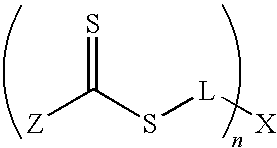Biomedical devices
a biomedical device and lens technology, applied in the field of biomedical devices, can solve the problems of hydrophobic areas of the lens, adversely affecting eye movement, comfort, and inability to wear comfortably in the eye, and achieve the effects of preserving the performance quality of the contact lens, preventing or restricting the adsorption of tear lipids, and preserving the clarity of the contact lens
- Summary
- Abstract
- Description
- Claims
- Application Information
AI Technical Summary
Benefits of technology
Problems solved by technology
Method used
Image
Examples
example 1
[0124]Preparation of 1,3,4,5 Tetrakis-(ethyl xanthyl)benzene having the following structure:
[0125]
[0126]Into a 1000 mL round bottom 3 neck flask fitted with a magnetic stirrer, nitrogen inlet, Freidrich's condenser, and a temperature probe was added 2.5 g of 1,2,4,5-tetrakis (bromo methyl)benzene, 4.5 g of potassium o-ethyl xanthate, and 400 mL of 50:50 tetrahydrofuran:ethanol. The reaction flask was placed in an ice bath at 0° C. and stirred for 24 hours. Next, 250 mL of deionized water was added to the flask. The crude mixture was extracted 4 times with 250 mL of 1:1:2 methylene chloride:ethyl ether: heptane retaining the organic layers. The combined organic layers were dried over anhydrous magnesium sulfate, filtered, and solvent was removed under reduced pressure to provide the product.
example 2
[0127]Preparation of a Multi-Armed Macromonomer having the structure:
[0128]
wherein each n is on average 13.
[0129]Into a one neck, 125 mL round bottom flask equipped with a magnetic stirring bar were added 480 mg of 1,2,4,5-tetrakis (ethyl xanthyl)benzene of Example 1 (0.000781 moles), 40 mL of NVP (41.6 g, 0.3743 moles), and 50 mL of anhydrous 1,4-dioxane. After these components were thoroughly mixed, 0.00517 g of AIBN (0.00000956 moles) was added to the round bottom flask. The round bottom flask was closed with an appropriately sized rubber septum and the contents of the flask were then purged by bubbling dry nitrogen gas for 1 hour at 10-15 mL / min. The contents of the reaction flask were heated to 60° C. with an oil bath (pre-set and pre-heated to ensure accurate heating) while maintaining a slow nitrogen flow (10-15 mL / min). The reaction was allowed to proceed for 18 hours under nitrogen while continuing to heat at 60° C. The reaction was then removed from the heating bath and al...
example 3
[0130]Preparation of a Multi-Armed Macromonomer having the structure:
[0131]
wherein each n is on average 13.
[0132]In a one neck, 125 mL round bottom flask equipped with a magnetic stirring bar were added 472 mg of 1,2,4,5-tetrakis (ethyl xanthyl)benzene of Example 1 (0.000764 moles), 40 mL of DMA (38.38 g, 0.3882 moles), and 50 mL of anhydrous 1,4-dioxane. After these components were thoroughly mixed, 0.0553 g of AIBN (0.000764 moles) were added to the round bottom flask. The round bottom flask was closed with an appropriately sized rubber septum and the contents of the flask were then purged by bubbling dry nitrogen gas for 1 hour at 10-15 mL / min. The contents of the reaction flask were heated to 60° C. with an oil bath (pre-set and pre-heated to ensure accurate heating) while maintaining a slow nitrogen flow (10-15 mL / min). The reaction was allowed to proceed for 18 hours under nitrogen while continuing to heat at 60° C. The reaction was then removed from the heating bath and allow...
PUM
| Property | Measurement | Unit |
|---|---|---|
| weight percent | aaaaa | aaaaa |
| weight percent | aaaaa | aaaaa |
| weight percent | aaaaa | aaaaa |
Abstract
Description
Claims
Application Information
 Login to View More
Login to View More - R&D
- Intellectual Property
- Life Sciences
- Materials
- Tech Scout
- Unparalleled Data Quality
- Higher Quality Content
- 60% Fewer Hallucinations
Browse by: Latest US Patents, China's latest patents, Technical Efficacy Thesaurus, Application Domain, Technology Topic, Popular Technical Reports.
© 2025 PatSnap. All rights reserved.Legal|Privacy policy|Modern Slavery Act Transparency Statement|Sitemap|About US| Contact US: help@patsnap.com



